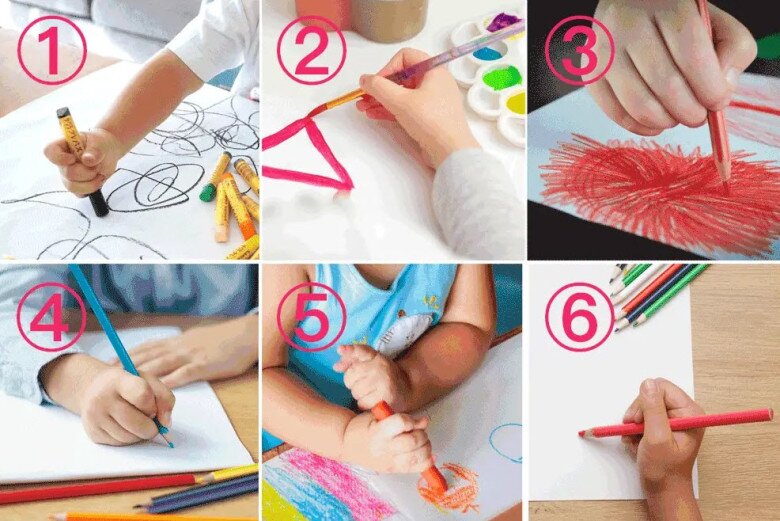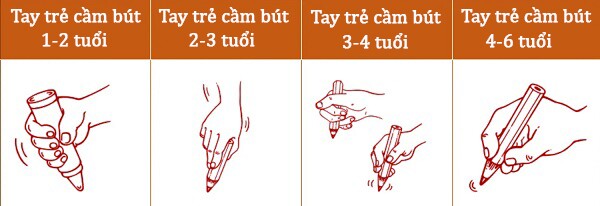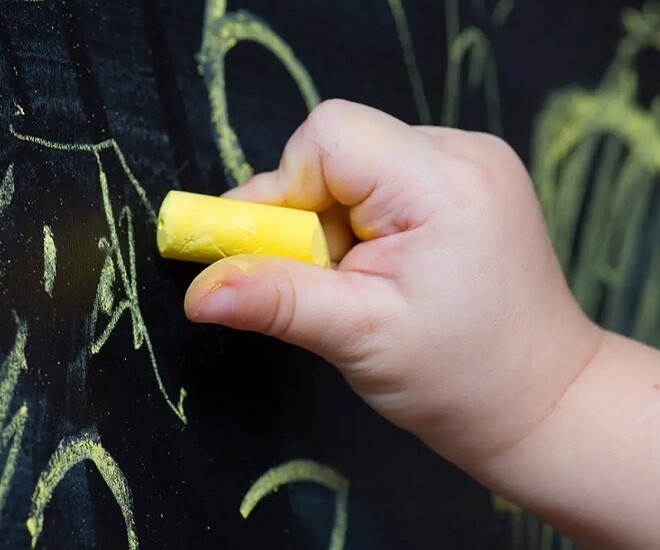Teaching your child how to hold a pencil correctly is important, and the best time to do this is between the ages of 4 and 6. This is the ideal window to guide them on the right posture and grip.

There are several common ways children grip a pencil, but what is the correct posture?

Why is the age of 4 to 6 years old the best time to guide children?
Whether a child can hold a pencil correctly depends on the strength of their hand and their fine motor skills. This development affects their writing ability and plays a significant role in various other skills in their daily life.
The correct pencil grip relies mainly on the movement of the thumb and index finger to maneuver the pencil, with the middle finger providing support. If a young child’s hands are not developed enough and you force them to hold a pencil, they will not be able to do so. This begs the question: At what age can children develop adequately?
There are 3 benefits to your child holding a pencil correctly.
The sequence of development for a child’s small hand is from the palm to the fingertips. Finger strength is the final stage of development, usually occurring after the age of 4. During this stage, finger strength will support their writing ability, and you will notice that their pencil grip starts to improve significantly.
Therefore, before the age of 4, it is not necessary to force your child to hold a pencil. The main goal is to strengthen their hands. To achieve this, parents should create opportunities for their children to exercise their small hands through fun and beneficial activities.
For instance, provide your child with various drawing tools such as colored pencils, chalk, paper, and watercolors, and encourage them to engage in creative games like playing with paper balls, clay, and scissors. These activities help strengthen their hands and develop their creativity and thinking skills.

How a child holds a pencil can vary with age.
After the age of 4, when a child’s hand strength has relatively stabilized, teaching them the correct pencil grip becomes more important. At this point, parents should pay attention to providing guidance to avoid the formation of bad habits.
Otherwise, when the child enters primary school after the age of 6, the amount of writing will increase significantly, and it will be more challenging to correct incorrect postures. Bad habits can lead to long-term problems with their writing ability, such as hand fatigue or poor handwriting.

How can you guide your child to the correct pencil grip?
Give your child a short, thick, and easy-to-hold paintbrush
Provide your child with a colored pencil or chalk, and let them progress naturally in holding the pencil with their fingers. This will create interest, develop their fine motor skills naturally and joyfully. When children become familiar with these tools, they will feel more comfortable using their hands for creative tasks, thus forming a good pencil grip habit.
At this point, parents can demonstrate the correct pencil grip for children to observe. Hold the pencil naturally, showing them how to use the thumb, index finger, and middle finger to create a firm and comfortable grip. To help them understand the grip better, encourage them to imitate your actions. You can also explain to them the importance of holding the pencil correctly, such as helping them write neater and reducing hand fatigue when writing.

Give your child a short, thick, and easy-to-hold paintbrush.
Guide them through the “Crocodile Eats Pencil” game
Step 1: Place your hand on the table and imagine that your hand is a crocodile with its mouth wide open. Ask your child to do the same and imagine that their hand is a big crocodile with sharp teeth.
Step 2: The crocodile is very hungry and wants to eat. It spots a pencil and takes a bite. Explain to your child that the crocodile needs energy to function and that the pencil is its favorite food. This imagery will make holding a pencil more interesting, like embarking on an adventure.
Step 3: The crocodile closes its mouth and starts to eat. However, the pencil becomes uncomfortable for the crocodile to swallow for a long time.
Let your child imagine that the crocodile is trying to swallow the pencil but can’t because it’s too big or uncomfortable. From this, they will understand that if they don’t hold the pencil correctly, writing will not be comfortable. For children, relating the pencil grip to the crocodile story will be more memorable and enjoyable.

Guide them through the “Crocodile Eats Pencil” game.
The story brings excitement and helps children remember the steps naturally. When they find the story interesting, they will be more receptive and willing to learn.
By following the laws of development and incorporating games into the learning process, children will naturally find the motivation and strength to change when the time is right. Instead of feeling pressured to memorize rigid rules, they will discover a new world where holding a pencil becomes part of a thrilling adventure.







































